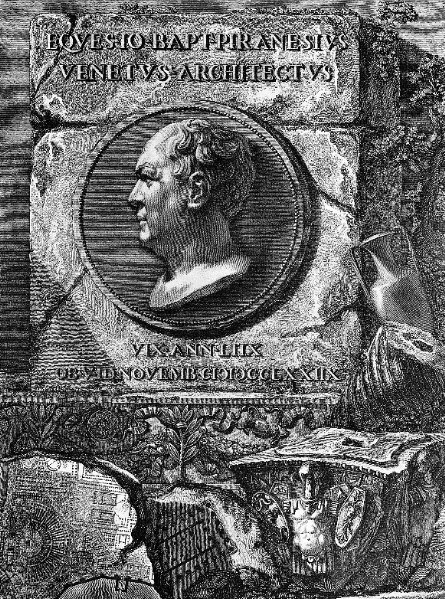program of the Area Martis
1997.12.29
Piranesi seems to have designed the Area Martis with the writings of Josephus in mind (as cited in Plattus "Passage into the City"). Piranesi calls the immediate zone around the adjacent Templum Martis "apparatorium triumphatorium"--place of preparation for the triumphal procession, and the many tabernae surrounding the Area Martis seem to be there to accomodate the triumphator and his troops the night before the day of procession. See Plattus p.104-5.
The first arch the procession goes through (and actually the only arch the way goes through within the Ichnographia) is the arch of Trajan. Although there is nothing spectacular in terms of triumph per se that is associated with Trajan. ...the "planned" lineage (literally) going from Trajan to Hadrian to Antoninus Pius along the longest axis (of life) -- from arch to tomb to arch--which corresponds with the historical lineage of imperial sucession. ...all the emperors from Nerva to Antoninus Pius are clearly "marked throughout the Horti Domitiae--there is a statue of Nerva beside the Templ. Plotinae.
Plotina - the wife of Trajan
1998.04.23
...the Templ. Plotinae at the east end of the axis of life is dedicated to Plotina, the wife of Trajan, and also the adoptive mother of Hadrian. This fits perfectly with the Imperial genealogy that is already apparent along the axis of life. Furthermore, the introduction of a "mother figure" directly on the axis of life consummates the notion of procreation that is already present.
...speculate that Piranesi is perhaps suggesting that there may have been some "incest" between Hadrian and Plotina.
Hadrian, Plotina, and Paulina Domitia, etc.
1998.06.02
According to the biography of Hadrian, he was a favorite of Plotina. In fact, there is some cause to believe that it was Plotina that got Hadrian named as sucessor at Trajan's deathbed. ...more symbolism along the axis of life.
Hadrian's birth mother's name was Paulina Domitia, and this fact lead to further speculation as to the meaning of the Sepulchra Familiae Domitorum at the end of the axis of death--the counter point of Hadrian's tomb. There is reference to both Hadrian's real mother and to his adoptive mother within the axes of life and death.
...sheds light on Piranesi's overall intention in (re-)designing (not reconstructing) the Campo Marzio. Piranesi was redrawing/redesigning the Campo Marzio, a redesign not at all capricious, but one based wholeheartedly on a vast amouint of historical facts. That is to say, Piranesi set out to improve the ancient Campo Marzio's "urban plan" without changing the region's existing program.
...reminded of Stirling's notion of evolutionary designing, and his statements about what could or should be considered when designing a house for K.F. Schinkel 200 years after Schinkel's birth. I am also reminded of Tafuri's wrongness in calling the Ichnographia of the Campo Marzio an "experimental design and therefore an unknown."
Piranesi operated on a few planes when generating his plan of the Campo Marzio--there is the redesigned plane, the Pagan-Christian narrative plane, and the plane of (composite?) temporal palimpsest. To make matters difficult, however, none of these planes complies completely with the other two, nor can any of the planes be viewed completely independent of the other two. In essence, Piranesi's (design) methodology emulates the very nature of Rome itself. The Ichnographia is a plan of many layers of meanings and messages which ultimately aptly represents Rome the city of many physical and historical layers.
As an archeologist, Piranesi "redraws" all the layers of Rome's ancient past. As a well educated 18th century Roman Catholic, he "drafts" the narrative of Rome's Pagan to Christian inversion (conversion), and as a highly evolved architect-designer he displays the "Eternal City" with infinite virtuality.
Matidia, Hadrian, mother-son theme
1998.06.28
...the Temple of Matidia, which Hadrian dedicated to his mother-in-law, was the first Roman temple named in honor of a woman. This further highlights the mother-son theme that involves Hadrian and Plotina, as well as his true mother Domitia.
| |
the portrait of Piranesi
1998.06.28
There is a portrait of Piranesi engraved by his son Francesco. The portrait is a profile set in a medalion, and the overall composition of the plate is in the Piranesi style. In the lower left corner, there is a stone fragment carved with plans, and it is indeed a fragment of the Ichnographia, specifically the Theater of Marcellus, the Minutia Vetus, and the Porticus Octavae. ...wonder if Francesco, or even Piranesi himself, saw the Ichnographia as Piranesi's greatest achievement. The four-sided Temple of Janus is also clearly delineated on the fragment.
...a case for the father-son theme that begins with Mars and Romulus (inversely God, the Father and His Son Jesus), and could include Augustus and Agrippa, and Trajan and Hadrian, and even Theodosius and Honorius.


|